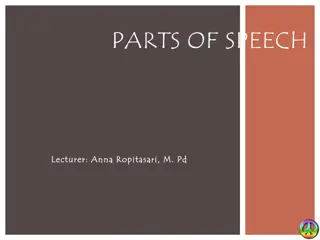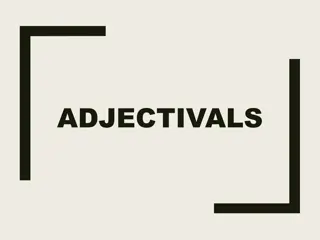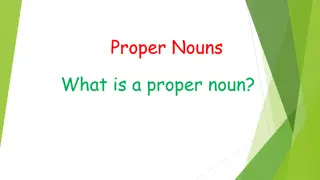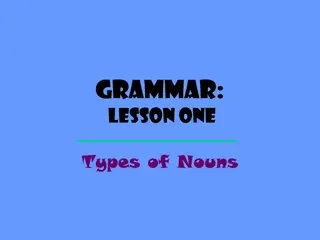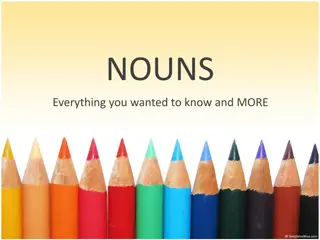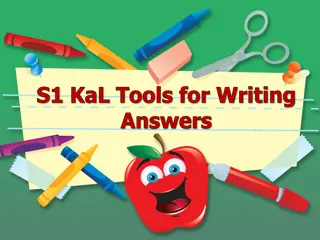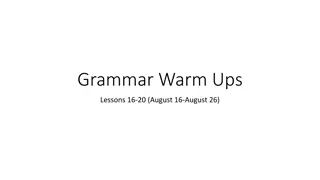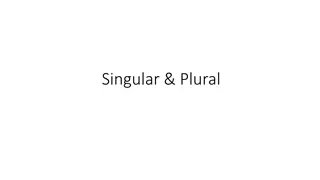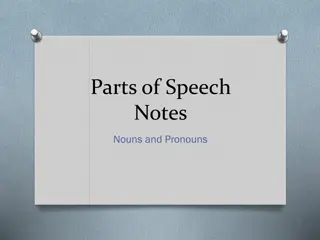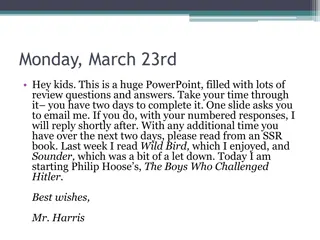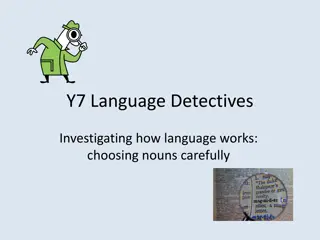Nouns: Types, Examples, and Usage
Delve into the world of nouns by exploring their definition, various types such as proper, common, countable, and uncountable, along with examples. Learn how to differentiate between different types of nouns and grasp their significance in language.
Download Presentation

Please find below an Image/Link to download the presentation.
The content on the website is provided AS IS for your information and personal use only. It may not be sold, licensed, or shared on other websites without obtaining consent from the author.If you encounter any issues during the download, it is possible that the publisher has removed the file from their server.
You are allowed to download the files provided on this website for personal or commercial use, subject to the condition that they are used lawfully. All files are the property of their respective owners.
The content on the website is provided AS IS for your information and personal use only. It may not be sold, licensed, or shared on other websites without obtaining consent from the author.
E N D
Presentation Transcript
Nouns Start the presentation by selecting View show from the Slide Show menu. Work through the presentation by left-clicking the mouse. You can make notes as you go. Use the left arrow key to return to an earlier slide. If you prefer to print the slides, make sure you follow these instructions: Do not just click the print button. 1. Select print from the file menu. 2. Select handouts; six slides per page; pure black & white. 3. Click OK.
WHAT ARE NOUNS? Nouns are naming words. They name people, places and objects. They can also name ideas, emotions, qualities and activities. Here are some examples of nouns: Peter, Elizabeth, driver, sister, friend. Bristol, Severn, Brazil, pen, dog, money. Love, beauty, industry, nature, greed, pain.
Typesof noun All nouns can be divided into common and proper nouns. Common nouns can then be divided into countable and uncountable nouns. Both countable and uncountable nouns can then be further divided into concrete and abstract nouns. We ll look at each type in turn.
First, look again at those types and how they relate. proper abstract nouns countable concrete common abstract uncountable concrete
Proper nouns Proper nouns start with capital letters. They are the names of people, places, times, organisations etc. They refer to unique individuals. Most are not found in the dictionary. They often occur in pairs or groups. Here are some examples.
The Jam Tony Blair Oxfam Coronation Street Carly Christmas Keynsham John President Bush Thames Sony China Coca Cola Bridget Jones Portugal The Ford Motor Company King Henry Macbeth Saturn
Common nouns All nouns which are not proper nouns are common nouns. A few examples: cup, art, paper, work, frog, bicycle, atom, family, mind. Common nouns are either countable or uncountable.
Countablenouns Use these tests for countable nouns: Countable (or just count ) nouns can be made plural: a tree two trees; a man men; a pony ponies. In the singular, they may have the determiner a or an: a sausage; an asterisk. We ask: How many words/pages/chairs? We say: A few minutes/friends/chips?
Uncountable nouns Use these tests for uncountable nouns: Uncountable (or non-count) nouns cannot be made plural. We cannot say: two funs, three advices or five furnitures. We never use a or an with them. We ask: How much money/time/milk? (Not How many?) We say: A little help/effort. (Not A few.)
Dual category nouns Some nouns may be countable or uncountable, depending on how we use them. We buy a box of chocolates (countable) or a bar of chocolate (uncountable). We ask: How much time? but How many times? (where times = occasions). We sit in front of a television (set) to watch television (broadcasting).
Field-specific nouns Uncountable nouns are often turned into countable nouns by specialists in a particular field.They become part of the jargon of that specialism. Grass is usually uncountable but botanists and gardeners talk about grasses. Linguists sometimes talk about Englishes. Financiers refer to moneys or even monies. Teas may be used to mean types of tea.
Remember that both countable and uncountable nouns can be divided into concrete and abstract nouns. The distinction between concrete and abstract nouns is the most important one of all when you are analysing linguistic data. A lot of abstract nouns in a text will have a big impact on its register. The Plain English Campaign has an excellent website which will tell you more about the stylistic impact of abstract nouns.
Concrete nouns Concrete nouns are the words that most people think of as nouns. They are mostly the names of objects and animals (countable) and substances or materials (uncountable). Cake, oxygen, iron, boy, dog, pen, glass, pomegranate, earthworm and door are all concrete nouns.
Abstract nouns Abstract nouns name ideas, feelings and qualities. Most, though not all, are uncountable. Many are derived from adjectives and verbs and have characteristic endings such as ity, -ness, -ence, and -tion. They are harder to recognise as nouns than the concrete variety.
Abstract noun or adjective You won t confuse abstract nouns with adjectives, as long as you apply a few tests. Happy is an adjective. It behaves like one: very happy; so happy; happier; as happy as Happiness behaves like a noun: The happiness I feel; her happiness; great happiness.
A few more examples Verb or adjective We were different from each other. My work is precise. Abstract noun The difference between us. I work with precision. The air is pure. I composed this tune. The purity of the air. This tune is my composition. It is so beautiful. You support me. It has such beauty. The support you give me.
The morphology of nouns Nouns change their form for only two grammatical reasons: Countable nouns have a plural form. This is usually formed by adding s, of course, but there are some irregular forms. The possessive form of a noun is created by adding s (Henry s cat) or just an apostrophe (all our students results).
Irregular plurals Some nouns retain plural endings from Old English: Men, geese, mice, oxen, feet, teeth, knives. Loan words from Latin, Greek, French and Italian sometimes keep their native ending: Media, bacteria, formulae, larvae, criteria, phenomena, gateaux. Graffiti, an Italian plural, is now an uncountable noun in English.
Noun phrases When we see a noun as performing a role in a sentence, we think of it as a noun phrase. A noun phrase may function as the subject or object of a clause. A noun phrase may consist of a single word (a noun or pronoun) or a group of words. The most important noun in a noun phrase is called the headword.
Examples of noun phrases (headword in brackets) (She) always bought the same (newspaper). A young (man) in a suit was admiring the (view) from the window. Concentrated sulphuric (acid) must be handled carefully. My old maths (teacher) was Austrian.
The syntax of noun phrases The headword of a noun phrase may be pre-modified by determiners, adjectives or other nouns. For example, a large, dinner (plate). It may be post-modified by a prepositional phrase. This is simply a noun phrase with a preposition at the beginning. For example, a (painting) by Rembrandt. Can you spot the modifiers in the last slide? (Left arrow key takes you back)
Clauses modifying nouns We can use a clause (a group of words containing a verb) to post-modify a noun. A clause which post-modifies a noun is called a relative clause or adjectival clause. Here are some examples: This is the (house) that Jack built. (People) who live in glass houses should not throw stones.
Thats the end of the presentation on nouns. If you want to print, remember the instructions: 1. Select print from the file menu. 2. Select: hand-outs; six slides per page; pure black and white. 3. Click OK .
This powerpoint was kindly donated to www.worldofteaching.com http://www.worldofteaching.com is home to over a thousand powerpoints submitted by teachers. This is a completely free site and requires no registration. Please visit and I hope it will help in your teaching.


